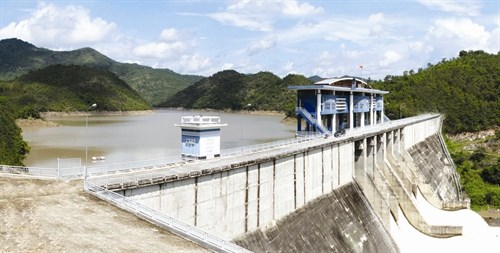 Society
Society

Irrigation works built in recent years has helped Bình Thuận Province sustainably develop agriculture and improve people’s lives.

|
| The Lòng Sông reservoir in Tuy Phong District is one of the major irrigation works in Bình Thuận Province. — VNA/VNS Photo Nguyễn Thanh |
BÌNH THUẬN — Irrigation works built in recent years has helped Bình Thuận Province sustainably develop agriculture and improve people’s lives.
The south-central province is one of the country’s driest and has inclement weather and little rainfall.
Most farming areas face a shortage of water in the dry season and farmers used to grow only one rice crop a year.
To mitigate the water shortage, the province built many irrigation works in the past years, and this is enabling rice farmers to grow more crops every year and get better yields.
The Sông Quao reservoir in Hàm Thuận Bắc District was one of the first irrigation works, with construction beginning in 1988 and taking 10 years due to the difficult conditions and weather.
The reservoir irrigates 11,000ha of farmland and supplies another 25,000cu.m to households in Phan Thiết City every day, according to the province Department of Agriculture and Rural Development.
Nguyễn Hoà, a farmer in Hàm Thuận Bắc’s Hàm Liêm Commune, said the reservoir has helped improve the lives of locals.
“We can now grow three rice crops a year. Besides, with sufficient irrigation water, we can also switch to other crops.”
Nguyễn Hữu Phước, deputy director of the department, said the province has 78 irrigation works with a combined capacity of 324 million cubic metres that provide water for 70,300ha of land.
It has built many large reservoirs like Sông Quao, Cà Giây and Lòng Sông, he said.
The irrigation works now supply water for more than 50 per cent of land and all households.
With the development of irrigation works, the farming area has increased from 32,600ha in 1992 to 114,500ha last year.
The rice yield topped 5.9 tonnes per hectare, up from 1.5 tonnes in 1992.
The area under perennial crops has now increased to 35.4 per cent from 12.6 per cent in 1992.
The country’s largest dragon fruit producing province has 33,500ha under the fruit and an annual output of 700,000 tonnes.
Water distribution canals
To effectively use irrigation works, Bình Thuận has built a system of inter-connected canals that transport water from large reservoirs to small ones to ensure all areas are provided with water in the dry season.
The Sông Móng – Đu Đủ – Tân Lập canal, for instance, is 40 kilometres long and supplies water for specialised dragon fruit growing areas in Hàm Thuận Nam District.
The province has 15 canals with a total length of 265 kilometres and they have helped increase irrigated farming areas by 18,000ha.
Huỳnh Duy Khôi, deputy chairman of the Bắc Bình District People’s Committee, said the canals have solved the problem of transporting irrigation water.
They have helped the district effectively restructure cultivation, he said.
The province’s irrigation works have helped develop agriculture sustainably and evenly in drought-prone areas in Tuy Phong, Bắc Bình and Hàm Thuận Bắc districts, according to local authorities.
It plans to build more large irrigation works.
One of them is the Ka Pét reservoir in Hàm Thuận Nam District, which will cost more than VNĐ1 trillion (US$43 million) and have a capacity of 50 million cubic metres.
It will provide water for irrigation and household use in Hàm Thuận Nam, Phan Thiết City and the province’s southern region.
The province is also preparing to build the La Ngà 3 reservoir, its largest at more than 470 million cubic metres.
The Government has granted funds for building it.
The reservoir will irrigate 80,000ha of land and provide another 300,000cu.m daily to households and industrial production, tourism, services and other sectors. — VNS




